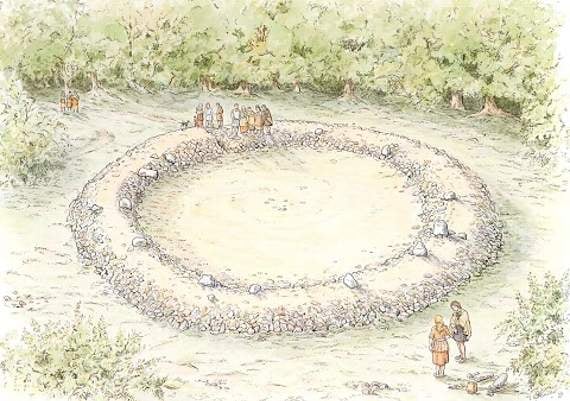AN archaeologist has spoken of his excitement at uncovering a 4,000-year-old ritual monument hidden in the Forest of Dean.
The Bronze Age ring cairn found in woodland near Tidenham is the only one ever found in Gloucestershire and features around 12 small standing stones set in the top of a bank in an almost perfect circle.
Archaeologist Jon Hoyle has revealed the discovery in a new book for Historic England, Hidden Landscapes of the Forest of Dean.
“We were doing some LiDAR – Light Detection and Ranging – mapping of the landscape from a plane, which is a relatively new technology using laser beams that allows us to take out the trees to give an accurate picture of what’s on the ground, when we first noticed this circular shape,” said Jon, who was directing the Forest of Dean Archaeological Survey for Gloucestershire County Council Archaeology Service at the time.
“We found several possible new archaeological sites, including this one, which was in woodland and completely overgrown.
“We thought this one worth investigating, so we got local amateur archaeologist Peter Bond to have a look, and he called back to say it was very overgrown, but there appeared to be a raised bank there and we should definitely come and see it.”
Jon thought it might be as modern as a Second World War gun emplacement when he headed out to the site on Forestry Commission land.
“I wasn’t thinking prehistoric ritual monument at the time,” he admitted. “But Peter then found a stone and when we uncovered a few more we realised we may have something really ancient.
“The stones aren’t that big, only up to 80cm high, but it was very exciting to find evidence of a ritual ring cairn, as we weren’t expecting anything like it.
“The Forestry Commission later cleared off the vegetation and when we got some funding we were able to go back and take a closer look to confirm our findings.”
Further investigation revealed a 25m wide raised circle around a seven-metre wide central mound.
“It’s a really important find, unique to Gloucestershire,” said Jon.
“You do see ritual ring cairns elsewhere, but mainly on uplands further west in Wales.
“We knew the Tidenham area had evidence of prehistoric activity, with various barrows and bumps having been found, including one barrow that was excavated in the 1950s.
“But finding a ritual ring cairn was a real surprise, because there aren’t any others that we know of around here.”
Exactly what its purpose was, however, remains a mystery,.
“We don’t really know what it was used for,” said Jon.
“Like stone circles, some of these sites are connected with burials, others with ritual burning, perhaps even sacrifices.
“There may have been processions ar-ound the outside of the ring, while the central part may have been a sacred area.
“The building of it alone may have been a sacred act, while it may have been used for a very long time and its use may have changed. We can only speculate.”
The exact location of the site has not been revealed in order to preserve the archaeology.
“Someone may do some more work there in the future, but at the moment it’s about managing it,” said Jon.
“We know that geo- physical mapping has provided some evidence of a pit inside the cairn.”
His new book, shown right, is a summary of the archaeological landscape of the southern Forest of Dean, from prehistoric to medieval times, incorporating Gloucestershire County Council Archaeology Service’s survey of the region, which included the use of LiDAR technology.
“There’s quite a lot of evidence of early mining and charcoal burning and even small fields in today’s woodland, which indicates people were probably living in the central parts of the woodland,” he said.
“Although we think of it as ancient forest, it wasn’t always covered in trees.
“We’ve also found a lot of Roman earthworks, including a possible Roman fortlet or late Iron Age structure in Ruardean.”
The Foresters’ Forest project is continuing to investigate some of the LiDAR findings, with the help of Worcestershire Archaeology.




